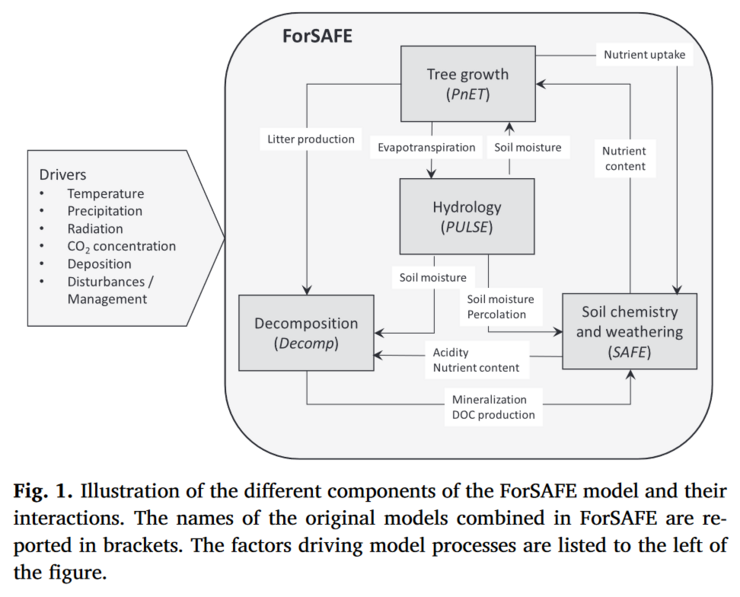Projekt SWIFT
Soil Weathering Rates in Forests (SWIFT)
Hintergrund
In den aktuell in Österreich laufenden Waldtypisierungsprojekten (WINALP21, FORSITE), werden die Wärme- und die Wasserhaushaltsachse mittels ausgewählter Klimaszenarien dynamisiert. Die Nährstoffachse wird bisher als gleichbleibend angenommen. Verwitterungsraten sind stark von der Temperatur abhängig und Studien haben nun gezeigt, dass auch diese klimasensitiv sind. Die Untersuchung von Verwitterungsraten und somit der Nährstoffnachlieferung unserer Böden ist somit ein weiterer wichtiger Baustein für die forstliche Standortskartierung und die daraus abgeleiteten Bewirtschaftungsempfehlungen für die Praxis.
Projektziele:
Modellierung von Verwitterungsraten, des Nährstoffkreislaufes und der Kohlenstoffspeicherung in Waldböden. Verknüpfung dieser geochemischen Prozesse mit der Substratklassifikation der Waldtypisierung Tirol.
- Modellierung der Basennachlieferung aus Verwitterung von Mineralböden und darunterliegenden Fest- oder Lockergesteinen
- Ableitung von nachhaltig möglichen Biomasseentzügen: auf Basis von aktuellen Nährstoffvorräten in Kombination mit der potentiellen Nachlieferung durch Verwitterung. Miteinbezug von Entzügen durch Holzernte, Bodenversauerung und Säureeinträge.
- Identifikation zusätzlicher Zuwachshemmnisse in Hochlagen aufgrund mangelnder Basenversorgung (zusätzlich zur klimatischen Veränderung)
- Einrichtung von Langzeitmonitoring für Verwitterungsraten
Methodik
Prozessbasierte dynamische Waldökosystem-Modellierung mit dem ForSAFE Modell.

Projektdauer
Projektlaufzeit: 2 Jahre, ab 01.12.2024
Parallelen zu nationalen und internationalen Projekten und Bestrebungen
Weiterentwicklung der Tiroler Waldtypisierung, Querverbindungen zu FORSITE I & II, EU Soil Monitoring Law, Tiroler Waldstrategie, Österreichische Waldstrategie; Beitrag zur österreichischen Bodenforschung, Mission SOIL & FTI Ziele (siehe ÖAW Call)
Projektpartner
Dr. Alois Simon (PI), Gruppe Forst, Amt der Tiroler Landesregierung
Dr. Salim Belyazid, Universität Stockholm (Institut für Geophysik)
In Kooperation mit dem Bundesforschungszentrum für Wald, Universität für Bodenkultur, GeoSphere Austria.
Project Description
Backgroundandscientificaspects
Soil weathering, both from geological substrates and in situ in soil, determines soil development, the supply of plant-available mineral nutrients, and the ability of soils to buffer acidification from atmospheric deposition (Blume et al., 2009). Driving factors for weathering rates are the mineralogy of the underlying geological substrates, soil texture, soil age, vegetation, microbial activity, atmospheric deposition and climate, and particularly temperature and soil moisture (Augusto et al., 2000; Oliva et al., 2003; Phillips et al., 2008; Egli et al., 2010; Palviainen et al., 2012). In general and over a wide range of temporal scales, soil weathering plays a crucial role in a large number of soil-based ecosystem services in the Alpine region (e.g. agricultural and forest biomass production, regulation of nutrient and carbon cycles, water filtration and purification). Nevertheless, soil information in mountain areas is scarce, especially on the nutrient status (e.g. base cation saturation, pH value) in forests (Baruck et al., 2016; Simon et al., 2020). In order to close this gap, forest site information has been generated in recent years for the Austrian provinces of Tyrol (Forest Site Classification Tyrol, 2018) and Styria (Amt der Steiermärkischen Landesregierung, 2022) and is currently being developed for Burgenland, Lower Austria and Upper Austria (FORSITE II-Project) (BLRT, 2021). Through these projects, the method of spatial modelling of forest site properties instead of terrestrial mapping has become established in mountainous regions. The novel dynamic modelling approaches also take into account the effects of climate change on thermal condition and water balance. In contrast, soil chemical properties (e.g. nutrient availability) are assumed to be constant over time. However, weathering rates have been shown to be strongly controlled by temperature (White et al., 1999) and soil moisture (Belyazid et al., 2022), and there is increasing evidence that weathering rates are sensitive to climate change (Kronnäs et al., 2023). The need to protect forest soils (Forest Act, 1975) in order to maintain their ecosystem services requires weathering rates to be assessed and taken into account when modelling forest site classification and developing management recommendations.
There are various approaches for determining weathering rates, depending on the methods (statical or process-based models), study scale (e.g. watershed, soil profile), and data availability and resources (e.g. element or isotope analysis, existing soil analyses) (Ahrends et al., 2018). However, determining weathering rates is difficult because these are very slow processes and complex to determine due to a large number of influencing factors. Therefore, process-based modelling approaches are frequently used. Numerous studies have demonstrated the potential of the soil chemistry model PROFILE (Warfvinge and Sverdrup, 1992) for large-scale applications (Houle et al., 2011; Block et al., 2016; Akselsson et al., 2019) and its practical suitability in catchments and different locations in Europe and North America (Hodson et al., 1996; Kolka et al., 1996; Eggenberger and Kurz, 2000; Whitfield et al., 2006; Phelan et al., 2014). It is also cited by the Working Group on Forest Site Classification (Arbeitskreis Standortskartierung, 2016) as the most commonly used method for estimating weathering rates. Furthermore, the methods used are based on mineralogy and are considered to be the most robust for estimating weathering rates (Mongeon et al., 2010). The weathering submodel of the steady- state PROFILE model was later built into the dynamic version SAFE (Alveteg et al., 1995), which is now an integral part of the dynamic forest ecosystem model ForSAFE (Wallman et al., 2005; Belyazid et al., 2006). The comparability of model results and the added value of dynamic models over steady-state models have been demonstrated (Akselsson et al., 2019; Kronnäs et al., 2019). The application of this modelling approach, which to our knowledge has not been applied to Austrian forest soils yet, is therefore considered to be promising for the dynamic assessment of weathering rates in response to climate change.
The various approaches for determining weathering rates all have their advantages and disadvantages, and long-term in situ studies to assess soil weathering rates are generally scarce in Europe. The buried test-mineral (rock) method is one of the most widely used (Hatton et al., 1987; Jamet et al., 1996; Augusto et al., 2001; Van Rompaey et al., 2007; Palviainen et al., 2012). In this method, permeable bags containing homogeneous test material (rock pellets or specific grain sizes) are buried in the soil and the change in mineral content is analysed after a specified time period (e.g. 10 to 20 years). Long- term studies of this kind are lacking, as they produce scientific results after a long period of time only and hence have to be carried out by established institutions with permanent staff and a high degree of planning security. Another challenge for such studies is the high spatial heterogeneity of soil properties in the field, especially in mountain soils (Stöhr, 2007). Nevertheless, mountain forests in Tyrol are suited for this type of study because they offer steep environmental gradients (e.g. elevation/temperature, precipitation, soil bedrock material), and relatively low management impacts over long time periods as well as good accessibility.
Aim and Objectives
We aim to apply a process-based approach to modelling weathering rates, nutrient cycles and carbon budgets at the soil profile and forest stand scale, to make inference at the landscape scale. We would like to link the “subsolum geological substrate (SSGS) information” of the forest site classification in Tyrol with the chemical and physical processes in the soil.
Objectives
- Allocate the contributions of the mineral soil and the parent material of soil formation to mineral weathering and consequently to base cation replenishment in forest ecosystems.
- Assessment of the potential sustainable biomass use (nutrients) by means of estimating weathering rates in comparison to losses due to harvesting and leaching.
- Identify a potential nutritional bottleneck in the optimum growth of trees in higher altitudes: due to a lack of base cations as nutrient limitations may occur in addition to climate change induced temperature or moisture limitations.
- Establishalong-terminsitustudyonsoilweatheringrates,usingtheburiedtestmineralmethod.
Model Selection
As outlined in the chapter on background and scientific aspects, numerous studies have demonstrated the potential of the soil chemistry model PROFILE and its further development in the dynamic forest ecosystem model ForSAFE for modelling soil weathering rates. The optimal application of this model family shall be achieved in collaboration with the model developers at the Department of Physical Geography, Stockholm University, Sweden, as a project partner. For this reason, approximately 20 % of the project budget and the corresponding travel expenses are reserved for this collaboration.
Linkage to national and international programs and networks
The project is committed to the UN Sustainable Development Goals, in particular to goal 15 and 13. Under SDG 15, sustainable management of forest and land and its halt of land degradation (including soils) is explicitly mentioned. The SDG 13 includes actions to combat climate change and its impacts. This is also in line with the second pillar of the political strategy on Climate Smart Forestry, which is about adapting forest management activities in order to build resilient forests (Kauppi et al., 2018). Furthermore, we are directly contributing to the Forest Strategy of the Provincial Government of Tyrol regarding its goals of nutrient sustainability in forest soils and sustainable biomass supply. The project further advances multiple actions of the Austrian Forest Strategy 2020+, e.g. increasing knowledge on the effect of climate change on Austrian forests, establishment and maintenance of resilient forest ecosystems, forest ecosystem services and forest soils, to name a few. In addition, results of this project may be of assistance for the announced Soil Health Law Initiative of the European Union, since this initiative seeks to specify characteristics of healthy soils and further promotes the sustainable use of soils. The proposed project will make an important contribution to the thematic areas of LTRE through process-oriented ecosystem research (Mirtl et al., 2015) by establishing a long-term in situ study on soil weathering rates in a functionally and structurally important ecosystem compartment.
Weiterführende Links
https://www.oeaw.ac.at/ess/sonderausschreibung-future-soils-2024










